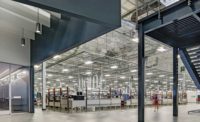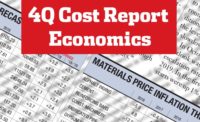Feeding off client optimism, many firms in manufacturing and industrial process see strong opportunities in the coming years, although some geographic regions may fare better.
“In terms of pure percentage of growth, manufacturing has been our largest growth sector this year,” says Marc Chabot, global major programs director at Golder.
In terms of geographic markets, lower oil prices and the availability of natural gas have been a boon for the U.S. market. As a result, some clients that traditionally would not have focused on North America are now looking at the U.S.
Further, political change is driving interest, says Andrew Ahrendt, director of corporate development and manufacturing at PCL Construction. “Many firms are buoyed by what they see from the Trump administration: tax reform, regulation reform, health-care reform. Companies are also looking to relocate to places with stable governments and a technical workforce,” he notes. “Those are all factors.”
In March, the National Association of Manufacturers released its annual Manufacturers’ Outlook Survey, which showed that more than 93% of respondents—the highest view in the survey’s 20-year history and up from 56.6% in March 2016—felt positive about their economic outlook.
Dave Watrous, vice president of life sciences and advanced manufacturing at Fluor, notes that, while much of its work in the pharmaceutical and biotech markets has been in Europe in recent years, some of that work is now heading to the U.S.
However, Watrous says he still sees a steady stream of opportunities in Europe, particularly in retooling and refurbishing existing facilities. Following the construction surge up to five years ago in large facilities in Europe, Watrous says he expects to see clients focus more on maximizing the facilities they already operate.
Although there has been some market hesitation related to Brexit, Watrous sees companies starting to release projects in the $20-million to $100-million range. “I expect to be in a smaller capital investment environment for the next few years, until that market rebounds and [clients] consume the idle space in their inventory,” he says.
In the manufacturing sector, the company recently completed an expansion of the Solvay Adhesives plant in Wrexham, Wales.
Watrous observes that, although many of its projects are smaller than a few years ago, the company is seeing double-digit growth in life sciences and advanced manufacturing, in part by capturing more market share.
In the automotive sector, the need to keep up with advances in vehicle technology is driving facility updates, says Duncan White, London-based leader for the science and industry business at Arup. “A lot of companies now are clearly looking at the electric-vehicle market,” he says. “There’s a need to create facilities now that are flexible for both gasoline engines and electric engines. The companies themselves are very unsure about how it’s going, and they don’t know how the market will react to the new technology. But it’s still a driver for those organizations.”
Similarly, White says advancements in automated vehicles are also on the near horizon. “We’re being asked to make facilities flexible for the future,” he adds.
Further, Arup is predicting that, with the increased use of robotics in manufacturing, it will need to design facilities that better reflect the changing culture of a plant. “[When] you use more robotics, the workforce in a factory moves from low cost and low skill to higher cost and higher skill,” he says.
The firm recently completed the £900-million Jaguar Land Rover Engine Manufacturing Centre, in Wolverhampton, England. The 185,000-sq-meter set of buildings house the machine and assembly halls, which are flanked by offices, social support spaces and a community education center. The facility aims to foster innovation, collaboration and the wellness of people at the facility, blurring the boundaries between production and offices.




Post a comment to this article
Report Abusive Comment